#governor in manipur
Explore tagged Tumblr posts
Text
The Ladakh Protest: The 21-day Hunger Strike led by Sonam Wangchuk
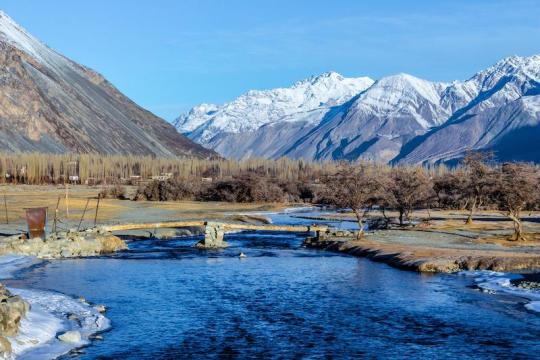
Ladakh, famously known as “Mars on Earth”, is the perfect destination where the mind slows down and the soul finds its path.
It is the northeastern Union territory of India, known for its highest mountain ranges, mesmerizing landscapes, beautiful deep valleys, crystal clear blue lakes, diverse wildlife, highest motorable mountain roads, Buddhist heritage, and the overall picturesque beauty of the place.
Ladakh: A union territory without legislature
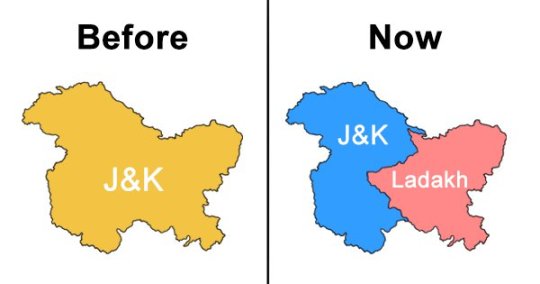
Ladakh, which was a part of Jammu and Kashmir since 1847, was separated from Indian-administered Kashmir in 2019 and was reconstituted as a Union territory on October 31, 2019.
People of Ladakh have constantly demanded separate territory since the 1930s due to the unfair treatment of Kashmir and the prevailing cultural differences between people of Kashmir and Ladakh.
The formation of Ladakh as a separate Union territory was widely celebrated. Still, people were disappointed because it was made a UT without a legislative assembly and would have a lieutenant governor, while Jammu and Kashmir had a legislature.
What does it mean to have no legislature in Ladakh?
Unlike J&K, Ladakh cannot elect its own representative.
Ladakh will be ruled directly by the central government through a lieutenant governor as an administrator.
The President of India has the power to form rules and regulations for Ladakh, according to Article 240.
Sonam Wangchuk following his Father’s footsteps
Sonam Wangyal was born in 1925 in a small village in the Leh district of Ladakh. He worked his entire life for the rights of the people of Ladakh. He had strong secular beliefs.
He was appointed as the MLC of Jammu and Kashmir from 1957–1967 and as the MLA from 1967–1972, due to his selfless service toward the people of Ladakh.
Wangyal was also an active member in the campaign for ST status for Ladakhis, which was carried out between 1982 and 1984.
In 1984, on his five-day hunger strike, the former Prime Minister, Indira Gandhi, visited Leh and requested Wangyal to withdraw from the strike with the promise of granting the status of ST to the people of Ladakh.

Following his father’s strong morals and values and showcasing his devotion to the land and people of Ladakh, Sonam Wangchuk, a nature activist, engineer, innovator, and educationalist, began a “climate fast for 21 days” on March 6, 2024.
Why are they protesting?
The primary goal behind the protest is to raise awareness about the fragile ecosystem of Ladakh endangered by the growing industrial and developmental projects approved in New Delhi without consent, a threat posed as a result of having no legislative assembly in the Union territory of Ladakh.

The residents of Ladakh have two key demands:
Full-fledged statehood for Ladakh: the residents have demanded to elevate Ladakh’s status as a Union territory to a full-fledged state. This would enable Ladakh to have its own government and the right to form its own rules and regulations in favor of the land and people of the territory.
Integration of Ladakh in the 6th Schedule of the Constitution: The 6th Schedule aims to protect areas with tribal and indigenous populations. By including Ladakh in the 6th schedule, it would allow the state to establish autonomous districts and regional councils.
These elected bodies will have the power to administer and protect the tribal regions of the area. It would give the Ladakhis more control over water management, land use, and cultural preservation.
What is the government’s response to the ongoing protest?
Unlike the response and action taken upon the hunger strike carried out by Wangchuk’s father, the present-day government is MIA.
The current government seems unbothered by the demands and protests in Ladakh, just the way it is, and the deteriorating situation in Manipur.
The pioneers of the movement and every other active citizen in and out of Ladakh are furious about the inaction of the government and the PM, who knowingly promised in his 2019 manifesto of Lok Sabha, that Ladakh will be incorporated into the 6th schedule of the constitution. But apparently, they failed to honor their promises.
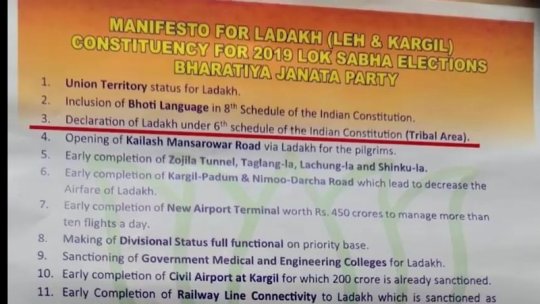
Lack of media coverage:
The lack of media coverage is infuriating for the people of Ladakh and the active citizens of India.
Although the independent media and journalists who are physically present in the ongoing protests do cover the news for the country, But it is disappointing to witness the lack of coverage by mainstream media and the big houses.
The scarcity of coverage of this major issue conceals the truth from the nation. The nation wants to know more about the concerns and affairs of the territory. Unless there is some news from the local media houses, the lack of coverage by the recognized media houses keeps the common man from knowing what is really happening there.
The current news on the Ladakh protest:
According to the current news,
Wangchuk survived solely on water and salt during the 21-day hunger strike (inspired by Gandhiji), which lasted from March 6th to March 26th.
In his speech, he talked about the “21-day fast"—that 21 days was the longest fast that Gandhiji kept during the independence movement.
Wangchuk states that the 21-day fast is over, but the protest will still continue. They will only rest when the government agrees to fulfill their demands.
Wangchuk said, “After me, women will begin a 10-day fast tomorrow. This will be followed by youth and Buddhist monks. Then it could be women, or I could come back. This cycle will go on.”
After ending his 21-day fast, Wangchuk stated “We will continue our struggle (in support of our demands). The gathering of 10,000 people at the venue and the participation of over 60,000 others over the past 20 days is a testimony of the people's aspirations.”
Conclusion:
All things considered, Ladakh, the "Land of High Passes," stands at a crossroads. While the echoes of their protests might fade from national headlines, the Ladakhi people's yearning for a brighter future persists. Whether they find resolution in the sixth schedule status or the full-throated roar of statehood, one thing is certain: Ladakh's story is far from over.
3 notes
·
View notes
Text
Can Any Indian Citizen Buy A Property In North East India?
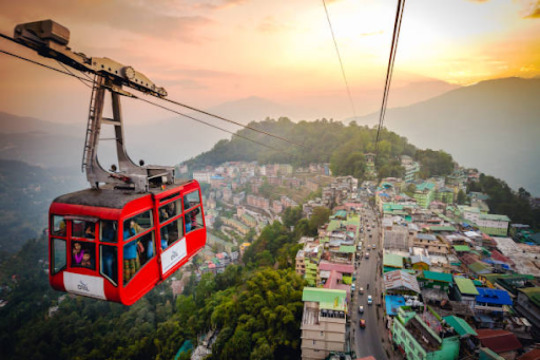
The Modi administration declared significant modifications to legislation in the Union Territory of Jammu and Kashmir on October 26th, using powers provided to the Centre underneath the Jammu and Kashmir Reorganisation Act 2019.
The headline modifications basically allow outsiders to acquire land in J&K by eliminating legislation and statutory rules of the former state that prohibited the ownership of property in J&K to 'permanent inhabitants'.
The lifting of limitations on outsiders purchasing land in J&K has long been hailed by proponents of the Modi government's decision to terminate the former state's special status. Governor Manoj Sinha has lauded the move's industrial ramifications, while BJP politicians like Sambit Patra have enthusiastically declared on social networks that anyone may now buy property in J&K.
Non-tribal people and foreigners are not permitted to purchase land in Sixth Schedule territories, while the Northeast has various state-specific regulations.
As Article 244 of the Indian Constitution, the Sixth Schedule contains provisions for the governance of tribal territories in Assam, Meghalaya, Tripura, and Mizoram.
Mizoram and Nagaland (except Dimapur) are, on the other hand, protected by Articles 371G and 371A of the Indian Constitution, and indigenous people have land ownership rights, and several states in the area have Inner Line Permit (ILP) provisions.
The Sixth Schedule of the Indian Constitution empowers Autonomous District Councils (ADCs) to pass rules prohibiting foreigners from purchasing tribal territory.
Articles 371A for Nagaland and 371G for Mizoram have provided specific authority to refuse any new Acts of Parliament until adopted by a resolution voted by the state's legislative assembly and to defend their rights to their land, customs, and religion.
Inner Line Permit (ILP) is relevant in Mizoram, Nagaland, and Arunachal Pradesh underneath the Bengal Eastern Frontier Regulation of 1873, which requires citizens from other parts of India to obtain permits to enter these states in order to control influx, and outsiders are not permitted to acquire property in the Sixth Schedule and other tribal areas, such as the hills of Manipur.
Prestone Tynsong, Deputy Chief Minister of Meghalaya, stated that there are Sixth Schedule and non-Sixth Schedule territories in Meghalaya.
"There are certain provisions for non-tribal people to acquire land in non-Sixth Schedule regions, including sections of the state capital Shillong as well as some grasslands of the Garo Hills area," Tynsong added.

Assam has several Sixth Schedule regions, and many parts fall underneath the tribal belt, where non-tribal people cannot acquire land. Under the Sixth Schedule of the Indian Constitution, there are three Autonomous Councils: the Bodoland Territorial Council, the Dima Hasao Autonomous District Council, and the Karbi Anglong Autonomous District Council.
Aside from these, Assam has 17 tribal straps and 30 blocks in the districts of Morigaon, Tinsukia, Darrang, Sonitpur, Nagaon, Lakhimpur, Kamrup, Goalpara, Dhemaji, and Bongaigaon, and four districts under the Bodoland Territorial Council (BTC) where non-tribals are prohibited from purchasing land.
#North East India#real estate#buy property#home buying#house buying#citizen#indian citizen buy property in north india
2 notes
·
View notes
Text
Manipur CM Biren Singh resigns a day ahead of Assembly session
Imphal, Feb 9 (IANS) Around two years after the ethnic violence broke out in Manipur and crippled the state, Chief Minister N. Biren Singh on Sunday submitted his resignation to Governor Ajay Kumar Bhalla a day before the crucial Assembly session. A Raj Bhavan official said that the Governor accepted the resignation letter and requested Biren Singh to continue as the caretaker Chief Minister…
0 notes
Text
Manipur: Why did CM Biren Singh resign? What’s next? New CM or president’s rule? What we know so far
Manipur: Biren Singh resigned as the Manipur Chief Minister on Sunday, February 9. He tendered his resignation to Governor Ajay Kumar Bhalla at the Raj Bhavan around 5:30 PM on Sunday. His resignation came as the ethnic violence in the northeastern state refused to settle down and claimed hundreds of lives in the past two years. Singh became the chief minister of the northeastern state for the…
0 notes
Text
[ad_1] Paromita Das GG News Bureau New Delhi, 24th Jan. A political storm erupted in Manipur when a viral letter by Janata Dal-United (JD(U)) Manipur Chief Ksh Biren Singh announced the withdrawal of support from the BJP-led state government. The announcement triggered a wave of reactions, with the opposition prematurely celebrating what they called a moral victory against the BJP. However, in a swift and calculated move, JD(U) central leadership, led by Bihar Chief Minister Nitish Kumar, dismissed the claims, sacked the Manipur unit chief, and reaffirmed its allegiance to the BJP-led NDA coalition both in Manipur and at the Centre. This episode highlights the deep cracks in JD(U)’s state units and the underlying challenges in maintaining political alliances in volatile environments like Manipur, where defections and shifting allegiances have become a norm. The Viral Letter and Its Fallout The crisis began when JD(U)’s Manipur Chief Ksh Biren Singh submitted a letter to Governor Ajay Kumar Bhalla, announcing the withdrawal of the party’s support for Chief Minister N. Biren Singh’s BJP government. The letter cited dissatisfaction over the defection of five of JD(U)’s six elected MLAs to the BJP following the 2022 Manipur Assembly elections, leaving JD(U) with only one legislator in the state assembly. JD(U) withdraws its support to BJP Government in Manipur. "In the election to State Assembly of Manipur held in 2022, six candidates set up by JD(U) were returned. After a few months, five MLAs of JD(U) defected to BJP…After JD(U) became a part of INDIA bloc, support to the… pic.twitter.com/f9uAtQ5SUY — ANI (@ANI) January 22, 2025 While the letter claimed alignment with the opposition I.N.D.I.A. alliance, JD(U)’s central leadership was quick to intervene. JD(U) national spokesperson Rajeev Ranjan Prasad termed the letter “misleading and baseless,” clarifying that the decision was neither authorized by the party’s central leadership nor discussed internally. The party immediately removed Ksh Biren Singh from his position as state unit chief, citing indiscipline. BJP-JD(U) Dynamics in Manipur JD(U)’s decision to publicly disown its Manipur unit’s move underscores the party’s commitment to maintaining its alliance with the BJP in Manipur. This is significant because, despite the defection of five JD(U) MLAs to the BJP after the 2022 elections, the BJP already holds a commanding majority in the 60-member assembly. With 37 BJP legislators supported by five Naga People’s Front MLAs and three Independents, the BJP government in Manipur is not reliant on JD(U)’s lone MLA. #WATCH | Delhi: JD(U) national spokesperson Rajeev Ranjan Prasad says, "This is misleading and baseless. The party has taken cognisance of this and the president of Manipur unit of the party has been relieved of his position. We have supported NDA and our support to the NDA… https://t.co/PhAJwAp4xn pic.twitter.com/usvowgta3n — ANI (@ANI) January 22, 2025 However, the political maneuvering by JD(U)’s Manipur unit also reveals the lingering tensions between the two parties at the state level. JD(U)’s central leadership, led by Nitish Kumar, has chosen pragmatism over conflict, signaling its priority to maintain its alliance with the BJP at the national level. The Opposition’s Short-Lived Celebration The letter initially sparked hope among opposition parties, particularly the Congress, which sought to frame it as a blow to BJP’s credibility. However, JD(U)’s quick dismissal of the letter and reaffirmation of its support for the BJP-led government in Manipur dashed those hopes. Congress leaders, who had begun projecting the letter as a shift in the political tides, were left scrambling for damage control after JD(U)’s clarification. This episode highlights the challenges faced by the I.N.D.I.A. alliance in consolidating opposition forces against the BJP, especially when allies like JD(U) appear unwilling to fully align with the coalition’s broader strategy. Nitish Kumar: A Master of Political Balancing
Nitish Kumar’s swift response to the Manipur controversy reflects his adeptness at political maneuvering, a skill that has helped him maintain relevance and power in Bihar and on the national stage. While his party opposed recent UGC rules introduced by the Modi government, Kumar ensured that JD(U) remained firmly aligned with the NDA in critical matters. Critics, however, point to Kumar’s history of flip-flopping alliances, questioning the long-term reliability of JD(U)’s commitments. In Bihar, his shifting loyalties between BJP and opposition alliances over the years have created an air of unpredictability around his leadership. This unpredictability, while frustrating for political opponents, has also allowed him to navigate complex political landscapes and retain power. The Bigger Picture The Manipur episode is emblematic of the fragility of political alliances in India, particularly in regions like the Northeast, where party defections and shifting loyalties are frequent. While JD(U)’s central leadership acted decisively to quell speculation, the incident highlights deeper issues within the party’s state units and its struggle to maintain coherence in a politically fragmented environment. For the BJP, this episode is a reminder of the challenges of coalition politics, even when commanding a majority. While the defection of JD(U) MLAs has strengthened BJP’s numbers in Manipur, the episode underscores the need to manage regional allies carefully to avoid unnecessary controversies. For opposition parties, the incident serves as a lesson in the perils of premature celebration. The opposition’s inability to consolidate forces against the BJP highlights the complexities of forming a cohesive anti-BJP front, particularly when regional parties like JD(U) prioritize pragmatism over ideology. Conclusion: A Storm Contained The viral letter by JD(U)’s Manipur chief may have sparked a political storm, but the party’s central leadership swiftly contained the fallout, reaffirming its alliance with the BJP and putting an end to opposition speculation. Nitish Kumar’s quick action reflects his commitment to maintaining JD(U)’s relevance in national politics, even as his history of shifting allegiances raises questions about the party’s long-term strategy. For the BJP, the episode is a minor blip in an otherwise stable political equation in Manipur. For the opposition, it underscores the need for more robust strategies to challenge BJP’s dominance, particularly in regions where defections and alliances can easily shift the balance of power. As Manipur’s political landscape stabilizes for now, the incident serves as a reminder of the delicate dance of coalition politics in India, where alliances are often tested by regional ambitions and internal divisions. The post Nitish Kumar’s JD(U) Crisis in Manipur: Realignment or Political Drama? appeared first on Global Governance News- Asia's First Bilingual News portal for Global News and Updates. [ad_2] Source link
0 notes
Text
[ad_1] Paromita Das GG News Bureau New Delhi, 24th Jan. A political storm erupted in Manipur when a viral letter by Janata Dal-United (JD(U)) Manipur Chief Ksh Biren Singh announced the withdrawal of support from the BJP-led state government. The announcement triggered a wave of reactions, with the opposition prematurely celebrating what they called a moral victory against the BJP. However, in a swift and calculated move, JD(U) central leadership, led by Bihar Chief Minister Nitish Kumar, dismissed the claims, sacked the Manipur unit chief, and reaffirmed its allegiance to the BJP-led NDA coalition both in Manipur and at the Centre. This episode highlights the deep cracks in JD(U)’s state units and the underlying challenges in maintaining political alliances in volatile environments like Manipur, where defections and shifting allegiances have become a norm. The Viral Letter and Its Fallout The crisis began when JD(U)’s Manipur Chief Ksh Biren Singh submitted a letter to Governor Ajay Kumar Bhalla, announcing the withdrawal of the party’s support for Chief Minister N. Biren Singh’s BJP government. The letter cited dissatisfaction over the defection of five of JD(U)’s six elected MLAs to the BJP following the 2022 Manipur Assembly elections, leaving JD(U) with only one legislator in the state assembly. JD(U) withdraws its support to BJP Government in Manipur. "In the election to State Assembly of Manipur held in 2022, six candidates set up by JD(U) were returned. After a few months, five MLAs of JD(U) defected to BJP…After JD(U) became a part of INDIA bloc, support to the… pic.twitter.com/f9uAtQ5SUY — ANI (@ANI) January 22, 2025 While the letter claimed alignment with the opposition I.N.D.I.A. alliance, JD(U)’s central leadership was quick to intervene. JD(U) national spokesperson Rajeev Ranjan Prasad termed the letter “misleading and baseless,” clarifying that the decision was neither authorized by the party’s central leadership nor discussed internally. The party immediately removed Ksh Biren Singh from his position as state unit chief, citing indiscipline. BJP-JD(U) Dynamics in Manipur JD(U)’s decision to publicly disown its Manipur unit’s move underscores the party’s commitment to maintaining its alliance with the BJP in Manipur. This is significant because, despite the defection of five JD(U) MLAs to the BJP after the 2022 elections, the BJP already holds a commanding majority in the 60-member assembly. With 37 BJP legislators supported by five Naga People’s Front MLAs and three Independents, the BJP government in Manipur is not reliant on JD(U)’s lone MLA. #WATCH | Delhi: JD(U) national spokesperson Rajeev Ranjan Prasad says, "This is misleading and baseless. The party has taken cognisance of this and the president of Manipur unit of the party has been relieved of his position. We have supported NDA and our support to the NDA… https://t.co/PhAJwAp4xn pic.twitter.com/usvowgta3n — ANI (@ANI) January 22, 2025 However, the political maneuvering by JD(U)’s Manipur unit also reveals the lingering tensions between the two parties at the state level. JD(U)’s central leadership, led by Nitish Kumar, has chosen pragmatism over conflict, signaling its priority to maintain its alliance with the BJP at the national level. The Opposition’s Short-Lived Celebration The letter initially sparked hope among opposition parties, particularly the Congress, which sought to frame it as a blow to BJP’s credibility. However, JD(U)’s quick dismissal of the letter and reaffirmation of its support for the BJP-led government in Manipur dashed those hopes. Congress leaders, who had begun projecting the letter as a shift in the political tides, were left scrambling for damage control after JD(U)’s clarification. This episode highlights the challenges faced by the I.N.D.I.A. alliance in consolidating opposition forces against the BJP, especially when allies like JD(U) appear unwilling to fully align with the coalition’s broader strategy. Nitish Kumar: A Master of Political Balancing
Nitish Kumar’s swift response to the Manipur controversy reflects his adeptness at political maneuvering, a skill that has helped him maintain relevance and power in Bihar and on the national stage. While his party opposed recent UGC rules introduced by the Modi government, Kumar ensured that JD(U) remained firmly aligned with the NDA in critical matters. Critics, however, point to Kumar’s history of flip-flopping alliances, questioning the long-term reliability of JD(U)’s commitments. In Bihar, his shifting loyalties between BJP and opposition alliances over the years have created an air of unpredictability around his leadership. This unpredictability, while frustrating for political opponents, has also allowed him to navigate complex political landscapes and retain power. The Bigger Picture The Manipur episode is emblematic of the fragility of political alliances in India, particularly in regions like the Northeast, where party defections and shifting loyalties are frequent. While JD(U)’s central leadership acted decisively to quell speculation, the incident highlights deeper issues within the party’s state units and its struggle to maintain coherence in a politically fragmented environment. For the BJP, this episode is a reminder of the challenges of coalition politics, even when commanding a majority. While the defection of JD(U) MLAs has strengthened BJP’s numbers in Manipur, the episode underscores the need to manage regional allies carefully to avoid unnecessary controversies. For opposition parties, the incident serves as a lesson in the perils of premature celebration. The opposition’s inability to consolidate forces against the BJP highlights the complexities of forming a cohesive anti-BJP front, particularly when regional parties like JD(U) prioritize pragmatism over ideology. Conclusion: A Storm Contained The viral letter by JD(U)’s Manipur chief may have sparked a political storm, but the party’s central leadership swiftly contained the fallout, reaffirming its alliance with the BJP and putting an end to opposition speculation. Nitish Kumar’s quick action reflects his commitment to maintaining JD(U)’s relevance in national politics, even as his history of shifting allegiances raises questions about the party’s long-term strategy. For the BJP, the episode is a minor blip in an otherwise stable political equation in Manipur. For the opposition, it underscores the need for more robust strategies to challenge BJP’s dominance, particularly in regions where defections and alliances can easily shift the balance of power. As Manipur’s political landscape stabilizes for now, the incident serves as a reminder of the delicate dance of coalition politics in India, where alliances are often tested by regional ambitions and internal divisions. The post Nitish Kumar’s JD(U) Crisis in Manipur: Realignment or Political Drama? appeared first on Global Governance News- Asia's First Bilingual News portal for Global News and Updates. [ad_2] Source link
0 notes
Text
मणिपुर में अजय भल्ला को ही राज्यपाल ���्यों नियुक्त किया गया ?
भारतीय प्रशासनिक सेवा (आईएएस) का एक अधिकारी जिसे केंद्र की मोदी सरकार ने लगातार चार बार सेवा विस्तार दिया और इसके बाद इस अधिकारी ने बतौर केंद्रीय गृह सचिव पांच साल पूरे किए. अधिकारी का नाम है अजय कुमार भल्ला और अब इन्हें हिंसाग्रस्त मणिपुर का राज्यपाल बनाया गया है. Why was Ajay Bhalla appointed as the Governor of Manipur मंगलवार को राष्ट्रपति भवन की ओर से जारी अधिसूचना में अजय कुमार भल्ला समेत…
0 notes
Text
Cyclone Remal Leaves Trail Of Destruction In Bengal, 2 Dead In Bangladesh
Severe cyclonic storm Remal made landfall between the coasts of West Bengal and Bangladesh, unleashing winds up to 135 kmph. The storm, which struck between Sagar Island and Khepupara near the southwest of Mongla in Bangladesh at 8:30 pm on Sunday, brought torrential rains, flooding homes and farmlands, leaving widespread destruction in its wake.
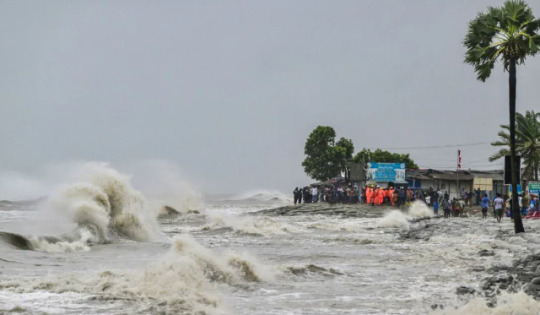
Two people were killed in Bangladesh since the cyclone made landfall last night, said an official from the country's disaster ministry. West Bengal has reported no casualty so far.
Ahead of the storm, disaster management authorities and security forces across Bengal and northeastern states were placed on high alert. District administrations in Assam, Meghalaya, Tripura, Manipur, and Mizoram were instructed to take precautionary measures to mitigate the impact.
Cyclone Remal disrupted air, rail, and road transportation in Kolkata and southern Bengal. The Eastern and South Eastern Railways cancelled several trains, and the Netaji Subhas Chandra Bose International Airport in Kolkata suspended flight operations for 21 hours, affecting 394 flights. The airport resumed operations at 9 am today. The Syama Prasad Mookerjee Port in Kolkata also halted operations.
In the city's Bibir Bagan area, a wall collapsed due to heavy rain injuring one person. Reports from North and South 24 Parganas and East Midnapore districts indicated extensive damage to thatched roofs, electric poles, and trees. Low-lying areas near Kolkata experienced severe flooding.
The Assam State Disaster Management Authority (ASDMA) issued warnings of extremely heavy rainfall across Assam and other northeastern states on May 27 and 28. Orange and Red alerts were issued for various districts, anticipating severe weather conditions. Squally winds of 40-50 kmph, gusting to 60 kmph, were expected over south Assam and Meghalaya.
The Meghalaya government advised residents to prepare emergency kits, avoid unnecessary travel, and stay updated with weather reports. Tripura's government closed all educational institutions on May 27 and 28 and suspended flight operations on the Kolkata-Agartala route until Monday morning.
Cyclone Remal damaged fragile dwellings, uprooted trees, and toppled electric poles. In the Sundarbans' Gosaba area, one person was injured by debris. Over one lakh people were evacuated from vulnerable areas in West Bengal before the cyclone struck.
The West Bengal government evacuated approximately 1.10 lakh people from coastal and vulnerable regions to cyclone shelters and other safe locations. Evacuations focused on South 24 Parganas, particularly Sagar Island, Sundarbans, and Kakdwip.
Prime Minister Narendra Modi chaired a meeting to review the storm response, while West Bengal Governor CV Ananda Bose monitored the situation closely. Bengal Chief Minister Mamata Banerjee urged residents to stay indoors, assuring them of governmental support.
The Kolkata Municipal Corporation (KMC) has mobilised 15,000 civic employees to manage post-cyclone recovery, including the quick removal of uprooted trees.
The India Meteorological Department (IMD) has predicted intensifying rains and winds in southern Bengal districts. Fourteen National Disaster Response Force (NDRF) teams have been deployed across affected districts, including Kolkata. The state government also readied State Disaster Response Force (SDRF) teams for relief efforts.
Nine disaster relief teams are on standby. The Indian Navy has prepared two ships with Humanitarian Assistance and Disaster Relief (HADR) supplies and medical aid. Specialised diving and flood relief teams are also on standby.
0 notes
Link
[ad_1] Guwahati: The Manipur Governor has summoned the long-pending session of the state assembly on August 29. The assembly had last convened for the budget session from February 21 to March 3. After the ethnic violence started in May, the government recommended a session by August 21, and later revised the date to August 28.The Article 174 of the Constitution maintains that "six months shall not intervene between its [state legislature] last sitting in one Session and the date appointed for its first sitting in the next Session".Over the last month, Opposition parties and Meitei civil society groups have been repeatedly asking for reconvention of the assembly.Sources said 10 Kuki MLAs might skip the session and the tribe's civil society might oppose it. The Kuki MLAs has refused to attend the session as the assembly is located in the Meitei-dominated Imphal Valley.Naga tribe MLAs, though, will attend the session, sources said. [ad_2]
0 notes
Text
Deep in disarray: On the larger message from the Legislative Assembly of Manipur not being convened
That the Legislative Assembly of Manipur was not convened on Monday, as recommended by the Council of Ministers, is an indication of how grave the crisis gripping the State is. Governor Anusuiya Uikey did not issue the notification summoning the House, even though the Cabinet had advised her on August 4 itself to call for the session on August 21. The delay on the part of Raj Bhavan in issuing…

View On WordPress
0 notes
Text
Manipur video: Why did police take over two months to act? Senior cop responds
On July 20, over two since the horrifying Manipur incident took place, four people were arrested – after a viral video of it went viral on social media.

It took more than a month for the FIR in connection with the sexual assault of two women in Manipur’s Kangpokpi district on May 4 to be transferred to the relevant police station since the victims had reportedly fled their homes and had complained to the police in another district.
On Thursday, over two since the horrifying incident took place, four people were arrested — after a viral video of it in which the women could be seen being paraded naked went viral on social media.
“Four main accused arrested in the Viral Video Case: 03 (three) more main accused of the heinous crime of abduction and gangrape under Nongpok Sekmai PS, Thoubal District have been arrested today. So a total 04 (four) persons have been arrested till now,” the Manipur Police tweeted.
Thoubal superintendent of police Sachidananda told The Indian Express that the police “could not take any action” so far due to “lack of evidence”.
Sachidananda, however, rejected the claims that cops were not present at the site at the time of the gruesome incident as “untrue”, the newspaper reported.
“That very day, the Nongpok Sekmai police station was being mobbed by people trying to loot arms. Police were busy guarding the police station,” the daily quoted the SP as saying.
One of the victims had earlier told IE that the police were there with the mob which was attacking their village. “The police picked us up from near home, took us a little away from the village and left us on the road with the mob. We were given to them by the police,” she was quoted as saying.
Village chief Thangboi Vaiphei, whose complaint later led to the registration of the FIR in the case, told HT that the thousand-strong mob plundered the village, forcing most of the residents, including the women and their two male relatives, to flee.
On May 4, as they came under attack from a mob that vandalised their homes, Vaiphei made frantic calls to the local police station, to no avail.
“When the first incidents of violence took place in Churachandpur on May 3, we informed the local police station and officers came. But on May 4, when we called them, they said they would not be able to come because the police station needed to be saved,” said 65-year-old Vaiphei, who served in the Indian Army’s infantry and retired as a junior commissioned officer (JCO) of the Assam Regiment in 2007, told HT.
As the mob plundered the village, the three women and others fled into the jungles.
“On seeing the church and houses being set on fire, the women fled the village with other residents and took shelter in the jungles on the hills,” said Vaiphei.
His complaint — first registered as a “zero FIR” on May 18 but forwarded to the appropriate police station only on June 21 — said the family was finally rescued by a police team from the Nongpok Samai police station 2km away.
But the mob waylaid them and “snatched” them from police custody — though in statements to some media outlets, one of the women later said they were handed over by the police to the mob — killed a man, before assaulting the women and parading them naked. One of the women was later gangraped, the FIR said, adding that the mob also killed her 19-year-old brother for trying to intervene. “The brother of the younger victim was butchered to death. Nobody came to the rescue of the older women,” Vaiphei said.
Manipur governor expresses strong condemnation
Manipur governor Anusuiya Uikey expressed her strong condemnation of the viral video and directed the director general of police (DGP) to take immediate steps to book the perpetrators of this heinous crime and award exemplary punishment as per law.
Amidst a nationwide outcry over the appalling incident in Manipur, chief minister N Biren Singh emphasised that his government would spare no effort in seeking the death penalty for the accused.
The violence in Manipur erupted after a rally by the All Tribal Students Union of Manipur (ATSUM) on May 3 in protest against the proposed inclusion of people belonging to the Meitei community in the list of Scheduled Tribes (STs).
0 notes
Text
The US is ready to assist if India asks for help in handling the violence in Manipur
U.S. Ambassador to India Eric Garcetti on Thursday said that the violence and killing in Manipur is a grave concern for humankind and that if asked, the US government is ready to assist India with the situation.
Mr. Garcetti was speaking at a conference where he talked about the multi-religious nature of Kolkata and added that the US has plans to invest more in the eastern and northeastern parts of India.
“Let me speak about Manipur first. We pray for peace there. When you ask us about the concern of the United States, I don’t think it’s a strategic concern. I think it’s about human concern... You don’t have to be Indian to care when you see children and individuals die in the sort of violence that we see [in Manipur] and we know that peace is the precedent for so many other good things. There have been so many good things in the northeast and the east here and those can’t continue without peace,” said Mr. Garcetti when asked about the US establishment’s views on the ongoing violence in Manipur.
“We stand ready to assist in any way if asked. We know it’s an Indian matter and we pray for peace and that it may come quickly. Because we can bring more collaboration, more projects, more investment if that peace is in place,” he added.
“One very clear message I want to send — the east of India and the northeast of India matters to the United States. Its people, its places, its potential, and its future matter to us,” he said.
As he visited Kolkata, Mr. Garcetti met West Bengal Governor C.V. Ananda Bose and Principal Chief Adviser to Chief Minister Amit Mitra.
For more international news in Hindi, subscribe to our newsletter.
#werindia#leading india news source#top news stories#world breaking news#world news#international news in hindi#manipur#Manipur Violence
0 notes
Text
Manipur Chief Minister likely to step down
IMPHAL: Amidst the ongoing violence in Manipur, there are strong indications that Chief Minister Biren Singh is likely to tender his resignation. A senior official in Manipur who is close to Singh, said that he is likely to resign on Friday. According to reports, Singh has an appointment with Governor Anusuiya Uikey, during which he may submit his resignation. The news of Biren Singh’s…
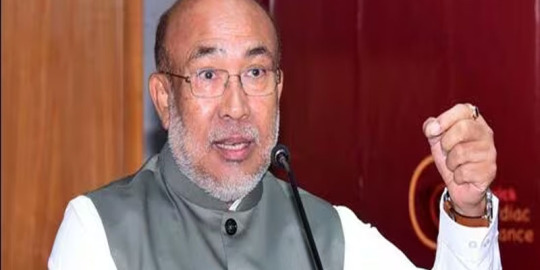
View On WordPress
0 notes
Text
Manipur CM Biren Singh resigns
Imphal: A day before a crucial Assembly session, Manipur Chief Minister N. Biren Singh Sunday submitted his resignation to Governor A.K. Bhalla In the letter to the Governor, Biren Singh said that he was “extremely grateful to the Central government for timely actions, interventions, developmental work and implementation of various projects for safeguarding the interest of every single…
0 notes
Text
Man killed in Manipur as governor visits relief camp in district | India News
GUWAHATI: Unidentified gunmen kept the pot boiling in restive Manipur for the sixth consecutive week, killing a 22-year-old man in a village of Churachandpur while governor Anusuiya Uikey was visiting relief camps for the displaced in the district Monday and wounding two others in another attack near the border between Kangpokpi and Imphal East.The Churachandpur attack occurred a little after 2pm…

View On WordPress
0 notes
Text
[ad_1] GG News Bureau Imphal, 3rd Jan. Former Union Home Secretary Ajay Kumar Bhalla took the oath as the 19th Governor of Manipur in a ceremony held at Raj Bhavan on Friday. The oath was administered by Manipur High Court Chief Justice D Krishnakumar, with Chief Minister N Biren Singh in attendance. Bhalla, who served as the longest-serving Union Home Secretary, brings extensive experience to the role. A retired 1984-batch Indian Administrative Service (IAS) officer from the Assam-Meghalaya cadre, he is known for his expertise and deep understanding of India’s internal security issues. His appointment comes amid ongoing ethnic clashes in Manipur between Meiteis and Kuki-Zo groups since May 2023. Following the oath-taking, Bhalla inspected the guard of honor by personnel of the Manipur Rifles. Chief Minister N Biren Singh praised Bhalla’s commitment and competence, expressing confidence that his appointment would pave the way for restoring normalcy and peace in the state. Singh welcomed Bhalla’s leadership, particularly in such challenging times for Manipur. Bhalla’s appointment follows the end of Assam Governor Lakshman Prasad Acharya’s additional charge as the governor of Manipur. Singh acknowledged the central government’s efforts in addressing the state’s issues and extended gratitude to Prime Minister Narendra Modi and Home Minister Amit Shah for Bhalla’s appointment. Bhalla, who retired as Union Home Secretary in August 2024, is viewed as a key figure to steer Manipur towards peace and stability. The post Former Union Home Secretary Ajay Kumar Bhalla Sworn in as Manipur Governor appeared first on Global Governance News- Asia's First Bilingual News portal for Global News and Updates. [ad_2] Source link
0 notes